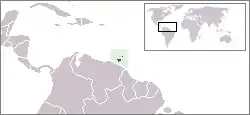Environment of Trinidad and Tobago
The environment of Trinidad and Tobago reflects the interaction between its biotic diversity, high population density, and industrialised economy.

Environment of Trinidad and Tobago
Biota/Fauna
The flora of Trinidad and Tobago is believed to include about 2,500 species of vascular plants.[1] There are about 50 species of freshwater fish (plus 30 marine species which are occasionally found in freshwater)[2] 400–500 marine fish species,[3] 30 amphibian species, about 90 reptiles,[2] 469 species of birds, and 98 mammal species.
Geography
Land
Climate change
Energy
Environmental policy and law
- Treaties and international agreements
Trinidad and Tobago is a signatory to a number of treaties and international agreements:
party to: Biodiversity, Climate Change, Climate Change-Kyoto Protocol, Endangered Species, Hazardous Wastes, Law of the Sea, Nuclear Test Ban, Ozone Layer Protection, Tropical Timber 83, Tropical Timber 94, Wetlands
signed, but not ratified: none of the selected agreements
Environmental issues
Environmental issues are water pollution from agricultural chemicals, industrial wastes, and raw sewage; oil pollution of beaches; deforestation; soil erosion.[4]
Trinidad and Tobago had a 2018 Forest Landscape Integrity Index mean score of 6.62/10, ranking it 69th globally out of 172 countries.[5]
See also
References
- Van den Eynden, Veerle; Michael P. Oatham; Winston Johnson (2008). "How free access internet resources benefit biodiversity and conservation research: Trinidad and Tobago's endemic plants and their conservation status". Oryx. 42 (3): 400–07. doi:10.1017/S0030605308007321.
- Kenny, Julian (2008). The Biological Diversity of Trinidad and Tobago: A Naturalist's Notes. Port of Spain: Prospect Press. ISBN 978-976-95082-3-1.
- Trinidad and Tobago Biodiversity Archived 2009-02-28 at the Wayback Machine Republic of Trinidad and Tobago Biodiversity Clearing House
- CIA World Fact Book
- Grantham, H. S.; Duncan, A.; Evans, T. D.; Jones, K. R.; Beyer, H. L.; Schuster, R.; Walston, J.; Ray, J. C.; Robinson, J. G.; Callow, M.; Clements, T.; Costa, H. M.; DeGemmis, A.; Elsen, P. R.; Ervin, J.; Franco, P.; Goldman, E.; Goetz, S.; Hansen, A.; Hofsvang, E.; Jantz, P.; Jupiter, S.; Kang, A.; Langhammer, P.; Laurance, W. F.; Lieberman, S.; Linkie, M.; Malhi, Y.; Maxwell, S.; Mendez, M.; Mittermeier, R.; Murray, N. J.; Possingham, H.; Radachowsky, J.; Saatchi, S.; Samper, C.; Silverman, J.; Shapiro, A.; Strassburg, B.; Stevens, T.; Stokes, E.; Taylor, R.; Tear, T.; Tizard, R.; Venter, O.; Visconti, P.; Wang, S.; Watson, J. E. M. (2020). "Anthropogenic modification of forests means only 40% of remaining forests have high ecosystem integrity - Supplementary Material". Nature Communications. 11 (1): 5978. doi:10.1038/s41467-020-19493-3. ISSN 2041-1723. PMC 7723057. PMID 33293507.
.svg.png.webp)